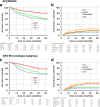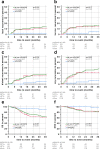Postoperative (chemo) radiation in patients with squamous cell cancers of the head and neck - clinical results from the cohort of the clinical cooperation group "Personalized Radiotherapy in Head and Neck Cancer"
- PMID: 29970111
- PMCID: PMC6029020
- DOI: 10.1186/s13014-018-1067-1
Postoperative (chemo) radiation in patients with squamous cell cancers of the head and neck - clinical results from the cohort of the clinical cooperation group "Personalized Radiotherapy in Head and Neck Cancer"
Abstract
Background: Postoperative (chemo) radiation improves tumor control and survival in high-risk patients with head and neck squamous cell carcinoma based on established risk factors. The clinical cooperation group "Personalized Radiotherapy in Head and Neck Cancer" focuses on the identification and validation of new biomarkers, which are aimed at eventually stratifying and personalizing the therapy concept. Hence, we reviewed all patients with head and neck squamous cell carcinoma of the oral cavity, oropharynx, hypopharynx, or larynx, treated with postoperative (chemo) radiation from 06/2008 until 06/2015 at the Department of Radiation Oncology in the University Hospital, LMU Munich. Here we report the clinical results of the cohort, laying the foundation for further research within the framework of a clinical cooperation group.
Methods: Patient data were retrospectively (until 2013) and prospectively (from 2013) collected and analyzed for outcome and treatment failures with regard to previously described and established risk factors.
Results: We identified 302 patients (median follow-up 45 months, average age 60.7 years), having received postoperative (chemo)radiation (median 64 Gy). Chemotherapy was added in 58% of cases, mostly Cisplatin/5- Fluorouracil in concordance with the ARO 96-3 study. The 3-year overall survival, local, locoregional and distant failure estimates were 70.5, 9.7, 12.2 and 13.5%, respectively. Human papillomavirus-associated oropharyngeal cancer was associated with a significant improved overall survival, locoregional, distant and overall tumor control rates in multivariate analysis. Additionally, in multivariate analysis, for local failure, resection status and perineural invasion, for locoregional and distant failure extracapsular extension and for overall survival the presence of nodal disease were significant adverse factors. Moreover, 138 patients have been treated in concordance with the ARO 96-3 protocol, corroborating the results of this study.
Conclusions: Our cohort represents a large unselected cohort of patients with head and neck squamous cell carcinoma treated with postoperative (chemo)radiation. Tumor control rates and survival rates are consistent with the results of previously reported data.
Keywords: Adjuvant; Chemoradiation; HNSCC; HPV; Head and neck cancer; Postoperative; Radiation therapy; Radiotherapy; Squamous cell carcinoma.
Conflict of interest statement
Ethics approval and consent to participate
For data analysis and the retrospective analysis of HPV p16 in some of the patients an ethics approval and consent was obtained (Ethics committee of the medical faculty of the LMU Munich. 448–13; 459–13; 17–116).
Consent for publication
Not applicable.
Competing interests
The authors declare that they have no competing interests.
Publisher’s Note
Springer Nature remains neutral with regard to jurisdictional claims in published maps and institutional affiliations.
Figures



References
-
- Rades D, Meyners T, Kazic N, Bajrovic A, Rudat V, Schild SE. Comparison of radiochemotherapy alone to surgery plus radio(chemo)therapy for non-metastatic stage III/IV squamous cell carcinoma of the head and neck: a matched-pair analysis. Strahlenther Onkol. 2011;187:541–547. doi: 10.1007/s00066-011-2262-2. - DOI - PubMed
MeSH terms
Substances
LinkOut - more resources
Full Text Sources
Other Literature Sources
Medical
Molecular Biology Databases

